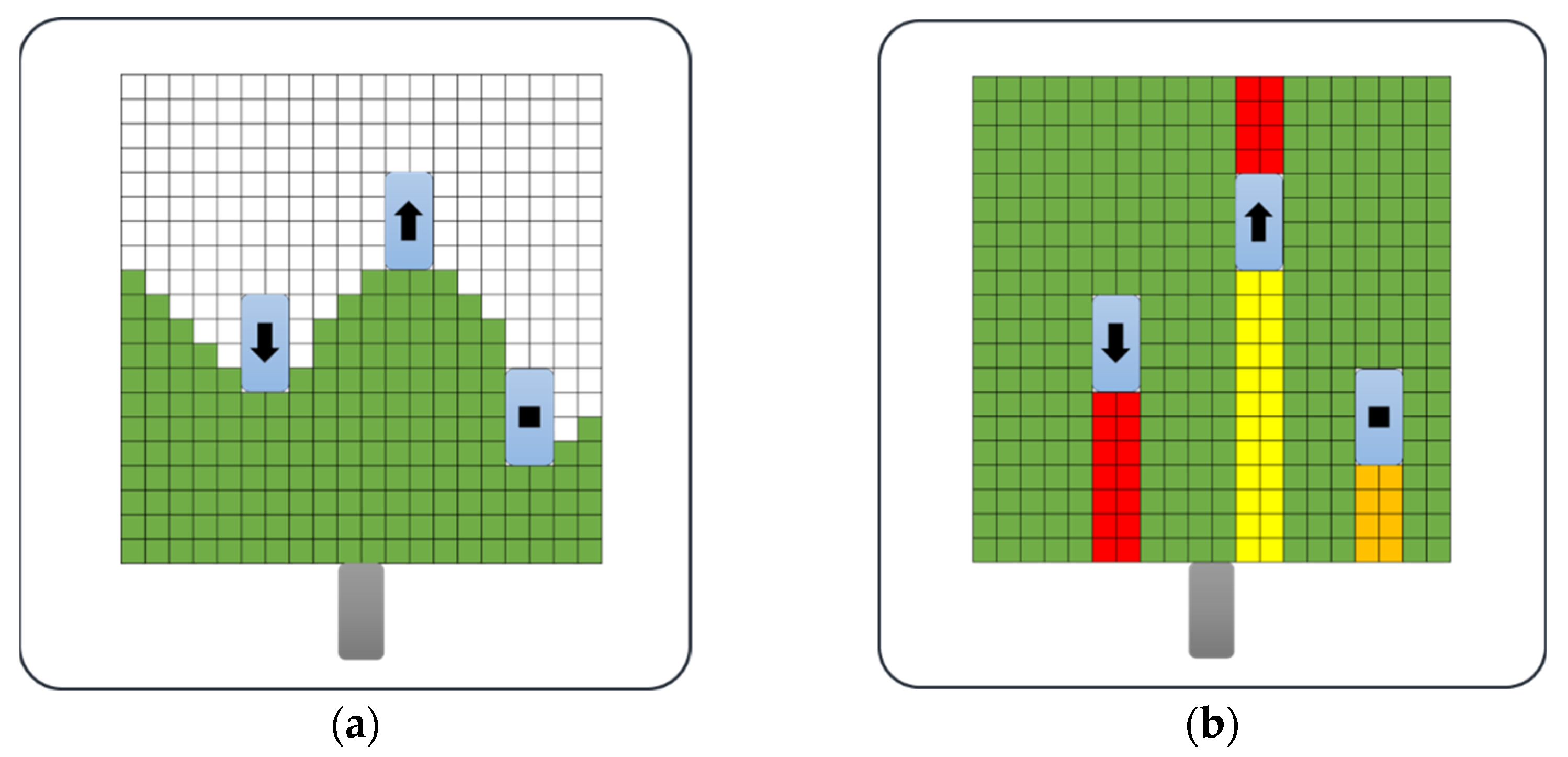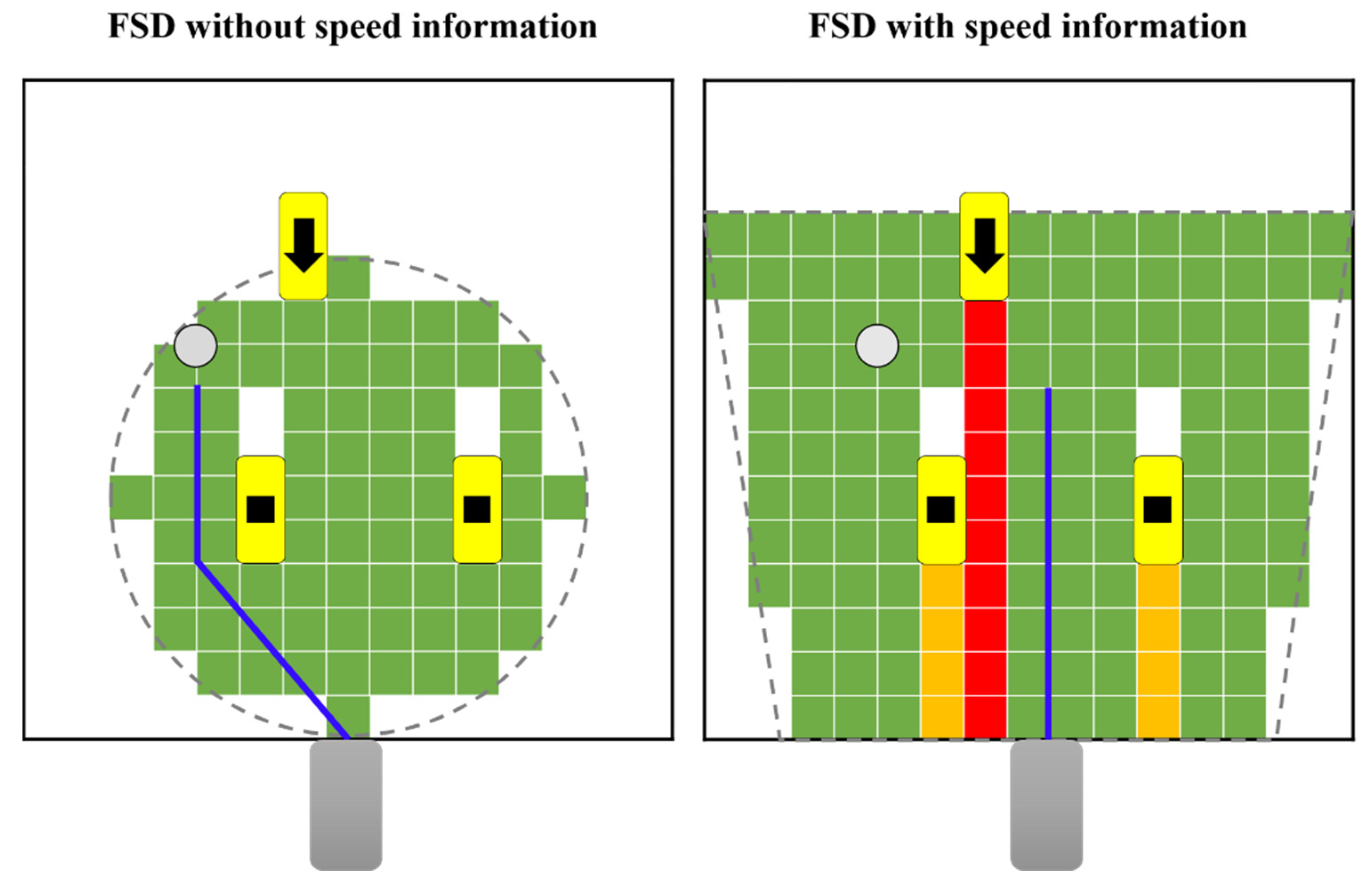Free Space Detection Algorithm Using Object Tracking for Autonomous Vehicles
Abstract
:1. Introduction
2. Materials and Methods
2.1. Clustering and Object Tracking
2.2. Grid Map
2.3. Free Space Detection (FSD)
| Algorithm 1. Free Space Detection (P, RS, VS, Sp) |
| for each obstacle P |
| if P exist |
| calculation RS |
| if RS ≥ 0 |
| mark Sp as able to drive |
| else if -VS < RS < 0 |
| mark Sp as unable to drive |
| else if RS < -VS |
| mark Sp as completely unable to drive |
| else |
| mark Sp as completely able to drive |
2.4. Path Generation
2.5. Time to Collision and Collision Risk
2.6. Experiment Environments
3. Results
4. Discussion
5. Conclusions
Author Contributions
Funding
Acknowledgments
Conflicts of Interest
References
- Eraqi, H.M.; Honer, J.; Zuther, S. Static free space detection with laser scanner using occupancy grid maps. arXiv 2018, arXiv:1801.00600. [Google Scholar]
- Fernández, C.; Gavilán, M.; Llorca, D.F.; Parra, I.; Quintero, R.; Lorente, A.G.; Vlacic, L.; Sotelo, M. Free space and speed humps detection using lidar and vision for urban autonomous navigation. In Proceedings of the 2012 IEEE Intelligent Vehicles Symposium, Alcala de Henares, Spain, 3–7 June 2012; pp. 698–703. [Google Scholar]
- Tao, J. 3D LiDAR based Drivable Road Region Detection for Autonomous Vehicles. Master’s Thesis, KTH Royal Institute of Technology, School of Electrical Engineering and Computer Science, Stockholm, Sweden, 2020. [Google Scholar]
- De Silva, V.; Roche, J.; Kondoz, A. Robust fusion of LiDAR and wide-angle camera data for autonomous mobile robots. Sensors 2018, 18, 2730. [Google Scholar] [CrossRef] [PubMed] [Green Version]
- Neumann, L.; Vanholme, B.; Gressmann, M.; Bachmann, A.; Kählke, L.; Schüle, F. Free space detection: A corner stone of automated driving. In Proceedings of the 2015 IEEE 18th International Conference on Intelligent Transportation Systems, Las Palmas de Gran Canaria, Spain, 15–18 September 2015; pp. 1280–1285. [Google Scholar]
- Pizzati, F.; García, F. Enhanced free space detection in multiple lanes based on single CNN with scene identification. In Proceedings of the 2019 IEEE Intelligent Vehicles Symposium (IV), Paris, France, 9–12 June 2019; pp. 2536–2541. [Google Scholar]
- Patra, S.; Maheshwari, P.; Yadav, S.; Banerjee, S.; Arora, C. A joint 3d-2d based method for free space detection on roads. In Proceedings of the 2018 IEEE Winter Conference on Applications of Computer Vision (WACV), Lake Tahoe, NV, USA, 12–15 March 2018; pp. 643–652. [Google Scholar]
- Pazhayampallil, J. Free Space Detection with Deep Nets for Autonomous Driving; Report; Stanford University: Stanford, CA, USA, 2014. [Google Scholar]
- Hänisch, S.; Evangelio, R.H.; Tadjine, H.H.; Pätzold, M. Free-space detection with fish-eye cameras. In Proceedings of the 2017 IEEE Intelligent Vehicles Symposium (IV), Redondo Beach, CA, USA, 11–14 June 2017; pp. 135–140. [Google Scholar]
- Li, M.; Feng, Z.; Stolz, M.; Kunert, M.; Henze, R.; Küçükay, F. High Resolution Radar-based Occupancy Grid Mapping and Free Space Detection. In Proceedings of the VEHITS, Madeira, Portugal, 16–18 March 2018; pp. 70–81. [Google Scholar]
- Hamandi, M.; Asmar, D.; Shammas, E. Ground segmentation and free space estimation in off-road terrain. Pattern Recognit. Lett. 2018, 108, 1–7. [Google Scholar] [CrossRef]
- Haltakov, V.; Belzner, H.; Ilic, S. Scene understanding from a moving camera for object detection and free space estimation. In Proceedings of the 2012 IEEE Intelligent Vehicles Symposium, Alcala de Henares, Spain, 3–7 June 2012; pp. 105–110. [Google Scholar]
- Kraemer, S.; Stiller, C.; Bouzouraa, M.E. LiDAR-based object tracking and shape estimation using polylines and free-space information. In Proceedings of the 2018 IEEE/RSJ International Conference on Intelligent Robots and Systems (IROS), Madrid, Spain, 1–5 October 2018; pp. 4515–4522. [Google Scholar]
- De Silva, V.; Roche, J.; Kondoz, A. Fusion of LiDAR and camera sensor data for environment sensing in driverless vehicles. arXiv 2017, arXiv:1710.06230v2. [Google Scholar]
- Yahya, M.A.; Abdul-Rahman, S.; Mutalib, S. Object detection for autonomous vehicle with LiDAR using deep learning. In Proceedings of the 2020 IEEE 10th International Conference on System Engineering and Technology (ICSET), Virtual Conference, Shah Alam, Malaysia, 9 November 2020; pp. 207–212. [Google Scholar]
- Lee, S.; Lee, D.; Choi, P.; Park, D. Accuracy–Power Controllable LiDAR Sensor System with 3D Object Recognition for Autonomous Vehicle. Sensors 2020, 20, 5706. [Google Scholar] [CrossRef]
- Zhao, X.; Sun, P.; Xu, Z.; Min, H.; Yu, H. Fusion of 3D LIDAR and camera data for object detection in autonomous vehicle applications. IEEE Sens. J. 2020, 20, 4901–4913. [Google Scholar] [CrossRef] [Green Version]
- Tang, L.; Shi, Y.; He, Q.; Sadek, A.W.; Qiao, C. Performance test of autonomous vehicle lidar sensors under different weather conditions. Transp. Res. Rec. 2020, 2674, 319–329. [Google Scholar] [CrossRef]
- Verucchi, M.; Bartoli, L.; Bagni, F.; Gatti, F.; Burgio, P.; Bertogna, M. Real-Time clustering and LiDAR-camera fusion on embedded platforms for self-driving cars. In Proceedings of the 2020 Fourth IEEE International Conference on Robotic Computing (IRC), Taichung, Taiwan, 9–11 November 2020; pp. 398–405. [Google Scholar]
- John, V.; Karunakaran, N.M.; Guo, C.; Kidono, K.; Mita, S. Free space, visible and missing lane marker estimation using the PsiNet and extra trees regression. In Proceedings of the 2018 24th International Conference on Pattern Recognition (ICPR), Beijing, China, 20–24 August 2018; pp. 189–194. [Google Scholar]
- Xu, F.; Chen, L.; Lou, J.; Ren, M. A real-time road detection method based on reorganized lidar data. PLoS ONE 2019, 14, e0215159. [Google Scholar] [CrossRef]
- Yao, J.; Ramalingam, S.; Taguchi, Y.; Miki, Y.; Urtasun, R. Estimating drivable collision-free space from monocular video. In Proceedings of the 2015 IEEE Winter Conference on Applications of Computer Vision, Waikoloa Beach, HI, USA, 5–9 January 2015; pp. 420–427. [Google Scholar]
- Kessler, T.; Minnerup, P.; Esterle, K.; Feist, C.; Mickler, F.; Roth, E.; Knoll, A. Roadgraph Generation and Free-Space Estimation in Unknown Structured Environments for Autonomous Vehicle Motion Planning. In Proceedings of the IEEE 2018 21st International Conference on Intelligent Transportation Systems (ITSC), Maui, HI, USA, 4–7 November 2018; pp. 2831–2838. [Google Scholar]
- Aihara, R.; Fujmoto, Y. Free-space estimation for self-driving system using millimeter wave radar and convolutional neural network. In Proceedings of the 2019 IEEE International Conference on Mechatronics (ICM), Ilmenau, Germany, 18–20 March 2019; pp. 467–470. [Google Scholar]
- Jang, C.; Sunwoo, M. Semantic segmentation-based parking space detection with standalone around view monitoring system. Mach. Vis. Appl. 2019, 30, 309–319. [Google Scholar] [CrossRef]
- Gkolias, K.; Vlahogianni, E. Convolutional neural networks for on-street parking space detection in urban networks. IEEE Trans. Intell. Transp. Syst. 2018, 20, 4318–4327. [Google Scholar] [CrossRef]
- Trejo, S.; Martinez, K.; Flores, G. Depth map estimation methodology for detecting free-obstacle navigation areas. In Proceedings of the 2019 IEEE International Conference on Unmanned Aircraft Systems (ICUAS), Atlanta, GA, USA, 11–14 June 2019; pp. 916–922. [Google Scholar]
- Chen, Y.; Zhou, L.; Bouguila, N.; Wang, C.; Chen, Y.; Du, J. BLOCK-DBSCAN: Fast clustering for large scale data. Pattern Recognit. 2021, 109, 107624. [Google Scholar] [CrossRef]
- Hasan, M.; Hanawa, J.; Goto, R.; Fukuda, H.; Kuno, Y.; Kobayashi, Y. Person Tracking Using Ankle-Level LiDAR Based on Enhanced DBSCAN and OPTICS. IEEJ Trans. Electr. Electron. Eng. 2021, 16, 778–786. [Google Scholar] [CrossRef]
- Munho, N. Development of Moving Object Detection Method for Automotive 3D LiDAR Sensor using Multi-Resolution Clustering Algorithm. Master’s Thesis, Graduate School, Kookmin Unuiversity, Seoul, Korea, 2019. [Google Scholar]
- Zhao, L.; Wang, M.; Su, S.; Liu, T.; Yang, Y. Dynamic Object Tracking for Self-Driving Cars Using Monocular Camera and LIDAR. In Proceedings of the 2020 IEEE/RSJ International Conference on Intelligent Robots and Systems (IROS), Las Vegas, NV, USA, 25–29 October 2020; pp. 10865–10872. [Google Scholar]
- Hong, Z.; Sun, P.; Tong, X.; Pan, H.; Zhou, R.; Zhang, Y.; Han, Y.; Wang, J.; Yang, S.; Xu, L. Improved A-Star Algorithm for Long-Distance Off-Road Path Planning Using Terrain Data Map. ISPRS Int. J. Geo-Inf. 2021, 10, 785. [Google Scholar] [CrossRef]
- Zheng, T.; Xu, Y.; Zheng, D. AGV path planning based on improved A-star algorithm. In Proceedings of the 2019 IEEE 3rd Advanced Information Management, Communicates, Electronic and Automation Control Conference (IMCEC), Chongqing, China, 11–13 October 2019; pp. 1534–1538. [Google Scholar]
- Jeong, S.; Gim, J.; Ahn, C. V2V Based Vehicle Detection and Collision Avoidance Algorithm. Trans. Korean Soc. Automot. Eng. 2018, 26, 773–782. [Google Scholar] [CrossRef]
- Li, Y.; Wu, D.; Lee, J.; Yang, M.; Shi, Y. Analysis of the transition condition of rear-end collisions using time-to-collision index and vehicle trajectory data. Accid. Anal. Prev. 2020, 144, 105676. [Google Scholar] [CrossRef] [PubMed]










| Previous Paper | Sensor | FSD with/without Obstacle Speed Information |
|---|---|---|
| [1] | Laser Scanner | without |
| [2] | LiDAR, Camera | |
| [3] | LiDAR | |
| [4] | LiDAR, Camera | |
| [5] | Camera | |
| [6] | Camera | |
| [7] | LiDAR, Camera | |
| [8] | Camera | |
| [9] | Camera | |
| [10] | Radar | |
| [11] | Camera | |
| [12] | Camera |
| Relative Speed of the Obstacle (S) | Possibility of Driving |
|---|---|
| No obstacles | CA |
| S ≥ 0 | A |
| -(vehicle speed) < S < 0 | UA |
| S < -(vehicle speed) | CUA |
| Possibility of Driving in a Demarcated Area | u |
|---|---|
| CA | 1 |
| A | 2 |
| UA | 3 |
| CUA | 4 |
| Specifications | Value |
|---|---|
| Channel | 16 channels |
| Measuring range | 100 m |
| Accuracy | Max ±3 cm |
| Field of view (vertical) | +15.0° to −15.0° |
| Field of view (horizontal) | 360° |
| Angular resolution (vertical) | 2.0° |
| Angular resolution (horizontal/azimuth) | 0.1–0.4° |
| Rotation speed | 5–20 Hz |
| Constant | Value |
|---|---|
| a | 0.46 |
| 6 | |
| 2 | |
| c | 4.3 |
| d | 2 |
| e | 0.1 |
| f | 1 |
| Case | CR | |
|---|---|---|
| FSD without Speed Information | FSD with Speed Information | |
| (a) | 21.21 | 18.97 |
| (b) | 89.60 | 14.56 |
| (c) | 75.97 | 68.95 |
| (d) | 11.95 | 5.84 |
| (e) | 23.31 | 21.57 |
| (f) | 107.89 | 54.43 |
Publisher’s Note: MDPI stays neutral with regard to jurisdictional claims in published maps and institutional affiliations. |
© 2021 by the authors. Licensee MDPI, Basel, Switzerland. This article is an open access article distributed under the terms and conditions of the Creative Commons Attribution (CC BY) license (https://creativecommons.org/licenses/by/4.0/).
Share and Cite
Lee, Y.; You, B. Free Space Detection Algorithm Using Object Tracking for Autonomous Vehicles. Sensors 2022, 22, 315. https://doi.org/10.3390/s22010315
Lee Y, You B. Free Space Detection Algorithm Using Object Tracking for Autonomous Vehicles. Sensors. 2022; 22(1):315. https://doi.org/10.3390/s22010315
Chicago/Turabian StyleLee, Yeongwon, and Byungyong You. 2022. "Free Space Detection Algorithm Using Object Tracking for Autonomous Vehicles" Sensors 22, no. 1: 315. https://doi.org/10.3390/s22010315
APA StyleLee, Y., & You, B. (2022). Free Space Detection Algorithm Using Object Tracking for Autonomous Vehicles. Sensors, 22(1), 315. https://doi.org/10.3390/s22010315





